Accounting for Business: Analysis of Business Enterprise Types, LSC
VerifiedAdded on 2023/06/16
|7
|1271
|100
Report
AI Summary
This report provides an overview of different types of business enterprises, including sole traders, partnerships, and companies, highlighting their characteristics and operational differences. It further distinguishes between common and preferred shares, explaining their features, voting rights, dividends, and claims to earnings. The report also discusses long-term debts, specifically debentures and bonds, comparing their security, rate of return, liquidation priority, risk factors, and convertibility. The analysis helps in understanding the financial structures and choices available to businesses when raising capital and managing their operations, providing a foundation for accounting and financial decision-making. This document is available on Desklib, a platform offering a range of study tools and resources for students.
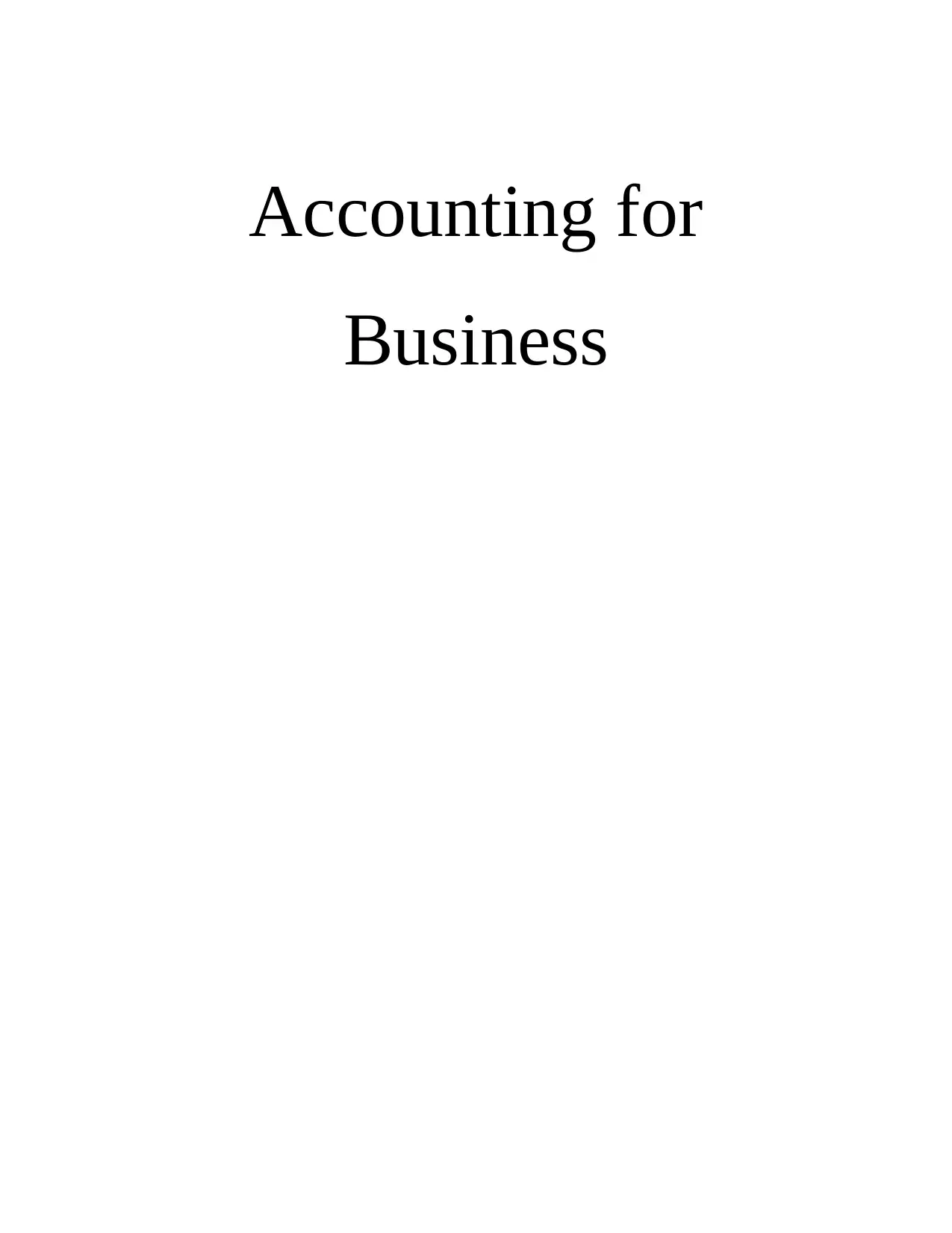
Accounting for
Business
Business
Paraphrase This Document
Need a fresh take? Get an instant paraphrase of this document with our AI Paraphraser
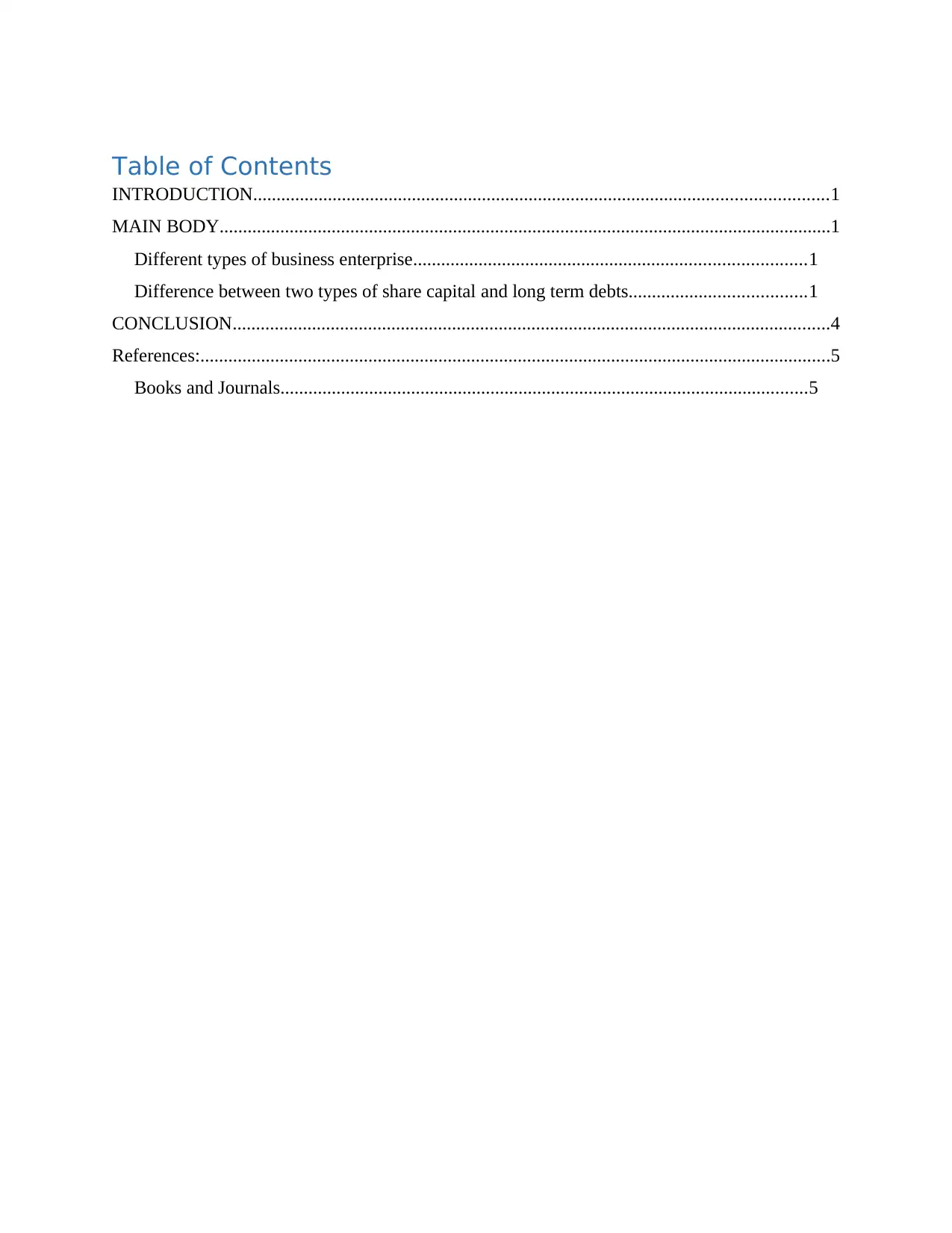
Table of Contents
INTRODUCTION...........................................................................................................................1
MAIN BODY...................................................................................................................................1
Different types of business enterprise....................................................................................1
Difference between two types of share capital and long term debts......................................1
CONCLUSION................................................................................................................................4
References:.......................................................................................................................................5
Books and Journals.................................................................................................................5
INTRODUCTION...........................................................................................................................1
MAIN BODY...................................................................................................................................1
Different types of business enterprise....................................................................................1
Difference between two types of share capital and long term debts......................................1
CONCLUSION................................................................................................................................4
References:.......................................................................................................................................5
Books and Journals.................................................................................................................5
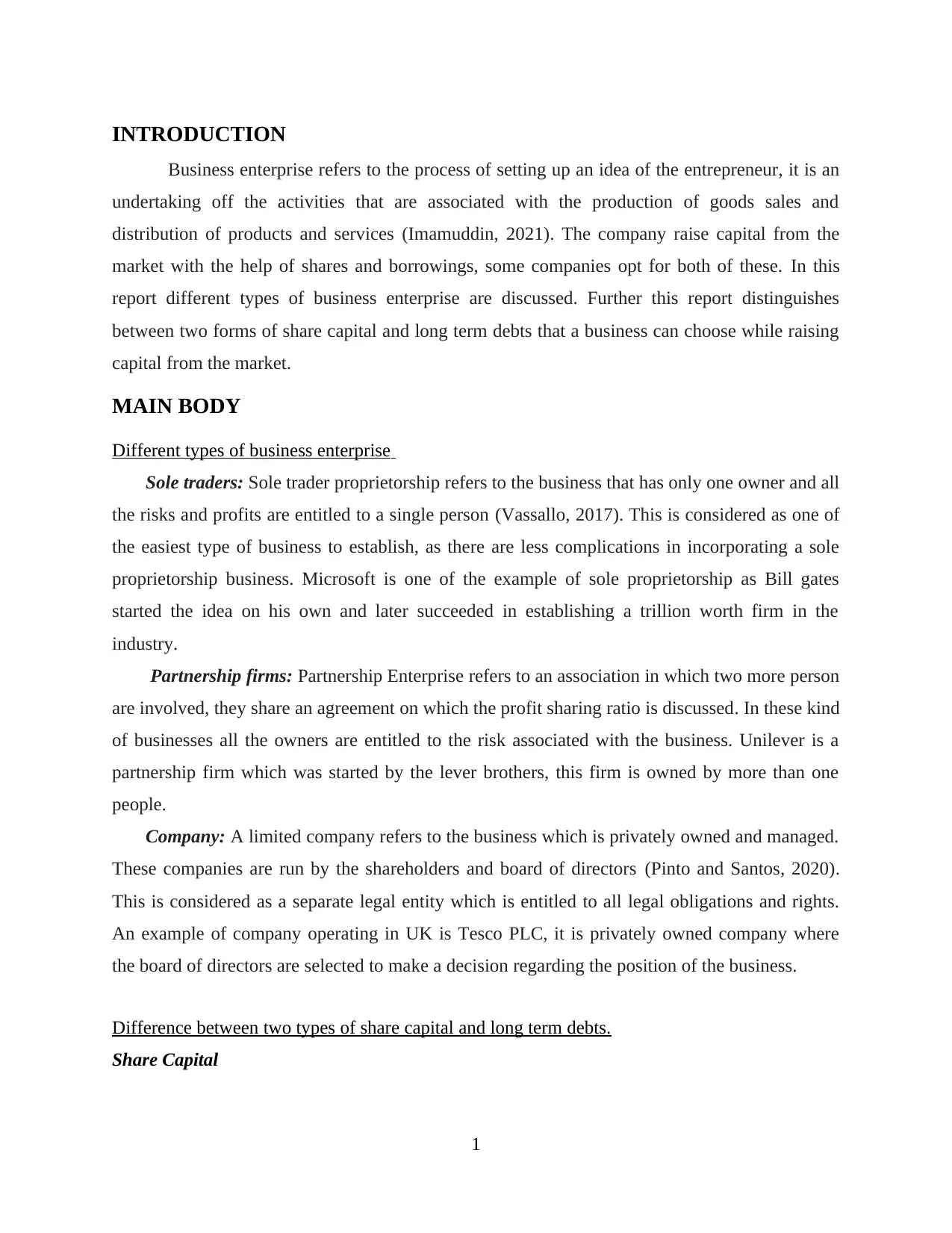
INTRODUCTION
Business enterprise refers to the process of setting up an idea of the entrepreneur, it is an
undertaking off the activities that are associated with the production of goods sales and
distribution of products and services (Imamuddin, 2021). The company raise capital from the
market with the help of shares and borrowings, some companies opt for both of these. In this
report different types of business enterprise are discussed. Further this report distinguishes
between two forms of share capital and long term debts that a business can choose while raising
capital from the market.
MAIN BODY
Different types of business enterprise
Sole traders: Sole trader proprietorship refers to the business that has only one owner and all
the risks and profits are entitled to a single person (Vassallo, 2017). This is considered as one of
the easiest type of business to establish, as there are less complications in incorporating a sole
proprietorship business. Microsoft is one of the example of sole proprietorship as Bill gates
started the idea on his own and later succeeded in establishing a trillion worth firm in the
industry.
Partnership firms: Partnership Enterprise refers to an association in which two more person
are involved, they share an agreement on which the profit sharing ratio is discussed. In these kind
of businesses all the owners are entitled to the risk associated with the business. Unilever is a
partnership firm which was started by the lever brothers, this firm is owned by more than one
people.
Company: A limited company refers to the business which is privately owned and managed.
These companies are run by the shareholders and board of directors (Pinto and Santos, 2020).
This is considered as a separate legal entity which is entitled to all legal obligations and rights.
An example of company operating in UK is Tesco PLC, it is privately owned company where
the board of directors are selected to make a decision regarding the position of the business.
Difference between two types of share capital and long term debts.
Share Capital
1
Business enterprise refers to the process of setting up an idea of the entrepreneur, it is an
undertaking off the activities that are associated with the production of goods sales and
distribution of products and services (Imamuddin, 2021). The company raise capital from the
market with the help of shares and borrowings, some companies opt for both of these. In this
report different types of business enterprise are discussed. Further this report distinguishes
between two forms of share capital and long term debts that a business can choose while raising
capital from the market.
MAIN BODY
Different types of business enterprise
Sole traders: Sole trader proprietorship refers to the business that has only one owner and all
the risks and profits are entitled to a single person (Vassallo, 2017). This is considered as one of
the easiest type of business to establish, as there are less complications in incorporating a sole
proprietorship business. Microsoft is one of the example of sole proprietorship as Bill gates
started the idea on his own and later succeeded in establishing a trillion worth firm in the
industry.
Partnership firms: Partnership Enterprise refers to an association in which two more person
are involved, they share an agreement on which the profit sharing ratio is discussed. In these kind
of businesses all the owners are entitled to the risk associated with the business. Unilever is a
partnership firm which was started by the lever brothers, this firm is owned by more than one
people.
Company: A limited company refers to the business which is privately owned and managed.
These companies are run by the shareholders and board of directors (Pinto and Santos, 2020).
This is considered as a separate legal entity which is entitled to all legal obligations and rights.
An example of company operating in UK is Tesco PLC, it is privately owned company where
the board of directors are selected to make a decision regarding the position of the business.
Difference between two types of share capital and long term debts.
Share Capital
1
⊘ This is a preview!⊘
Do you want full access?
Subscribe today to unlock all pages.

Trusted by 1+ million students worldwide
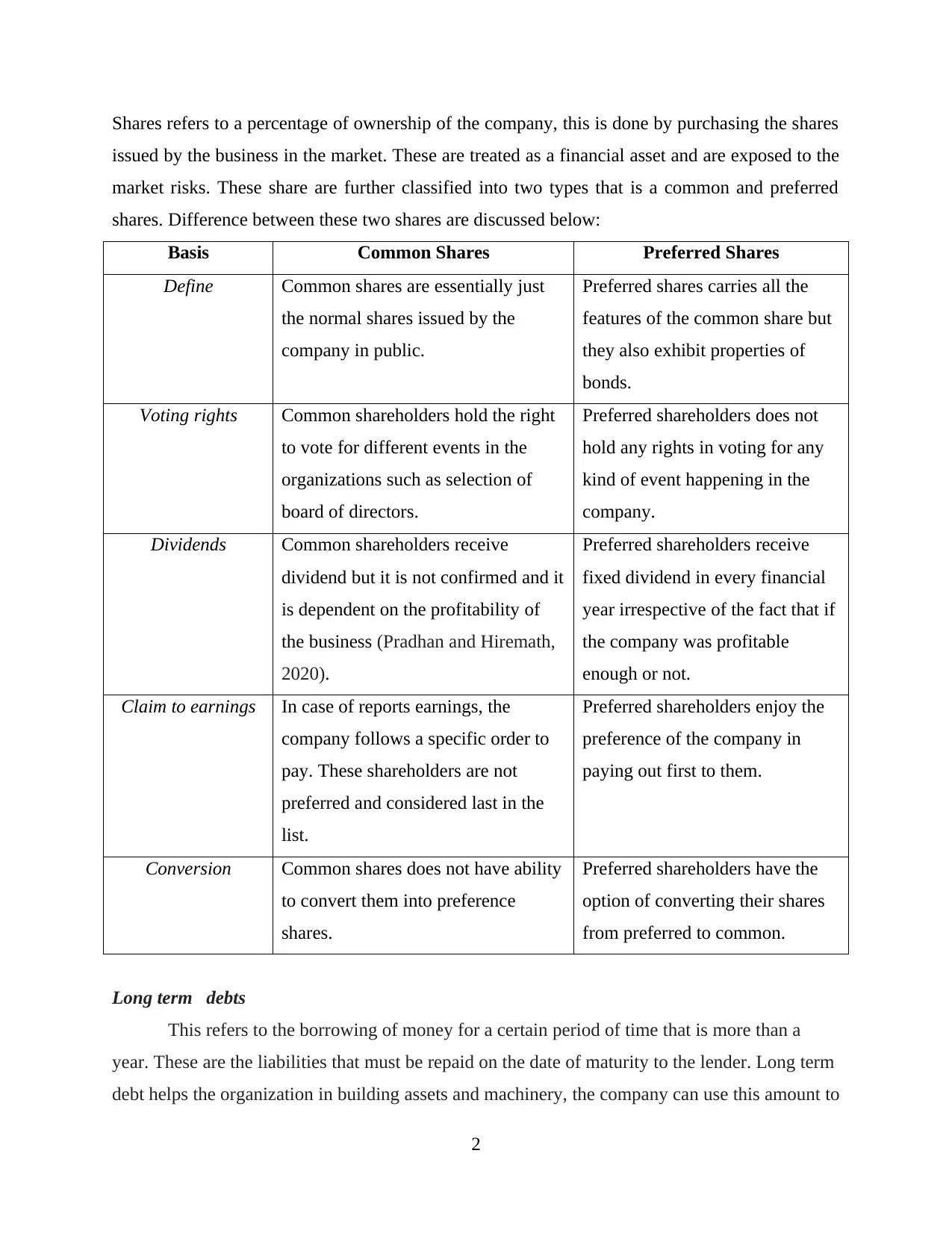
Shares refers to a percentage of ownership of the company, this is done by purchasing the shares
issued by the business in the market. These are treated as a financial asset and are exposed to the
market risks. These share are further classified into two types that is a common and preferred
shares. Difference between these two shares are discussed below:
Basis Common Shares Preferred Shares
Define Common shares are essentially just
the normal shares issued by the
company in public.
Preferred shares carries all the
features of the common share but
they also exhibit properties of
bonds.
Voting rights Common shareholders hold the right
to vote for different events in the
organizations such as selection of
board of directors.
Preferred shareholders does not
hold any rights in voting for any
kind of event happening in the
company.
Dividends Common shareholders receive
dividend but it is not confirmed and it
is dependent on the profitability of
the business (Pradhan and Hiremath,
2020).
Preferred shareholders receive
fixed dividend in every financial
year irrespective of the fact that if
the company was profitable
enough or not.
Claim to earnings In case of reports earnings, the
company follows a specific order to
pay. These shareholders are not
preferred and considered last in the
list.
Preferred shareholders enjoy the
preference of the company in
paying out first to them.
Conversion Common shares does not have ability
to convert them into preference
shares.
Preferred shareholders have the
option of converting their shares
from preferred to common.
Long term debts
This refers to the borrowing of money for a certain period of time that is more than a
year. These are the liabilities that must be repaid on the date of maturity to the lender. Long term
debt helps the organization in building assets and machinery, the company can use this amount to
2
issued by the business in the market. These are treated as a financial asset and are exposed to the
market risks. These share are further classified into two types that is a common and preferred
shares. Difference between these two shares are discussed below:
Basis Common Shares Preferred Shares
Define Common shares are essentially just
the normal shares issued by the
company in public.
Preferred shares carries all the
features of the common share but
they also exhibit properties of
bonds.
Voting rights Common shareholders hold the right
to vote for different events in the
organizations such as selection of
board of directors.
Preferred shareholders does not
hold any rights in voting for any
kind of event happening in the
company.
Dividends Common shareholders receive
dividend but it is not confirmed and it
is dependent on the profitability of
the business (Pradhan and Hiremath,
2020).
Preferred shareholders receive
fixed dividend in every financial
year irrespective of the fact that if
the company was profitable
enough or not.
Claim to earnings In case of reports earnings, the
company follows a specific order to
pay. These shareholders are not
preferred and considered last in the
list.
Preferred shareholders enjoy the
preference of the company in
paying out first to them.
Conversion Common shares does not have ability
to convert them into preference
shares.
Preferred shareholders have the
option of converting their shares
from preferred to common.
Long term debts
This refers to the borrowing of money for a certain period of time that is more than a
year. These are the liabilities that must be repaid on the date of maturity to the lender. Long term
debt helps the organization in building assets and machinery, the company can use this amount to
2
Paraphrase This Document
Need a fresh take? Get an instant paraphrase of this document with our AI Paraphraser
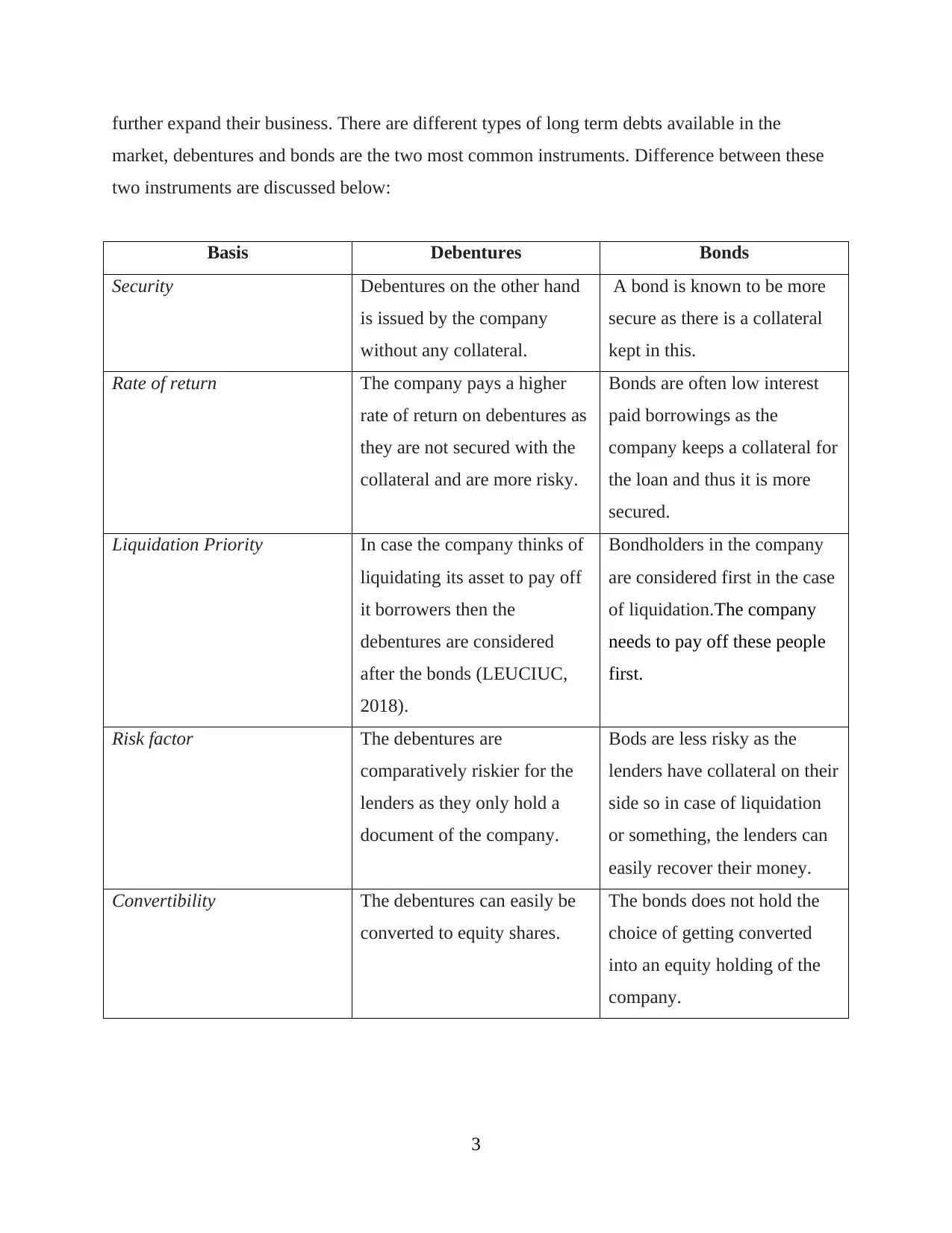
further expand their business. There are different types of long term debts available in the
market, debentures and bonds are the two most common instruments. Difference between these
two instruments are discussed below:
Basis Debentures Bonds
Security Debentures on the other hand
is issued by the company
without any collateral.
A bond is known to be more
secure as there is a collateral
kept in this.
Rate of return The company pays a higher
rate of return on debentures as
they are not secured with the
collateral and are more risky.
Bonds are often low interest
paid borrowings as the
company keeps a collateral for
the loan and thus it is more
secured.
Liquidation Priority In case the company thinks of
liquidating its asset to pay off
it borrowers then the
debentures are considered
after the bonds (LEUCIUC,
2018).
Bondholders in the company
are considered first in the case
of liquidation.The company
needs to pay off these people
first.
Risk factor The debentures are
comparatively riskier for the
lenders as they only hold a
document of the company.
Bods are less risky as the
lenders have collateral on their
side so in case of liquidation
or something, the lenders can
easily recover their money.
Convertibility The debentures can easily be
converted to equity shares.
The bonds does not hold the
choice of getting converted
into an equity holding of the
company.
3
market, debentures and bonds are the two most common instruments. Difference between these
two instruments are discussed below:
Basis Debentures Bonds
Security Debentures on the other hand
is issued by the company
without any collateral.
A bond is known to be more
secure as there is a collateral
kept in this.
Rate of return The company pays a higher
rate of return on debentures as
they are not secured with the
collateral and are more risky.
Bonds are often low interest
paid borrowings as the
company keeps a collateral for
the loan and thus it is more
secured.
Liquidation Priority In case the company thinks of
liquidating its asset to pay off
it borrowers then the
debentures are considered
after the bonds (LEUCIUC,
2018).
Bondholders in the company
are considered first in the case
of liquidation.The company
needs to pay off these people
first.
Risk factor The debentures are
comparatively riskier for the
lenders as they only hold a
document of the company.
Bods are less risky as the
lenders have collateral on their
side so in case of liquidation
or something, the lenders can
easily recover their money.
Convertibility The debentures can easily be
converted to equity shares.
The bonds does not hold the
choice of getting converted
into an equity holding of the
company.
3
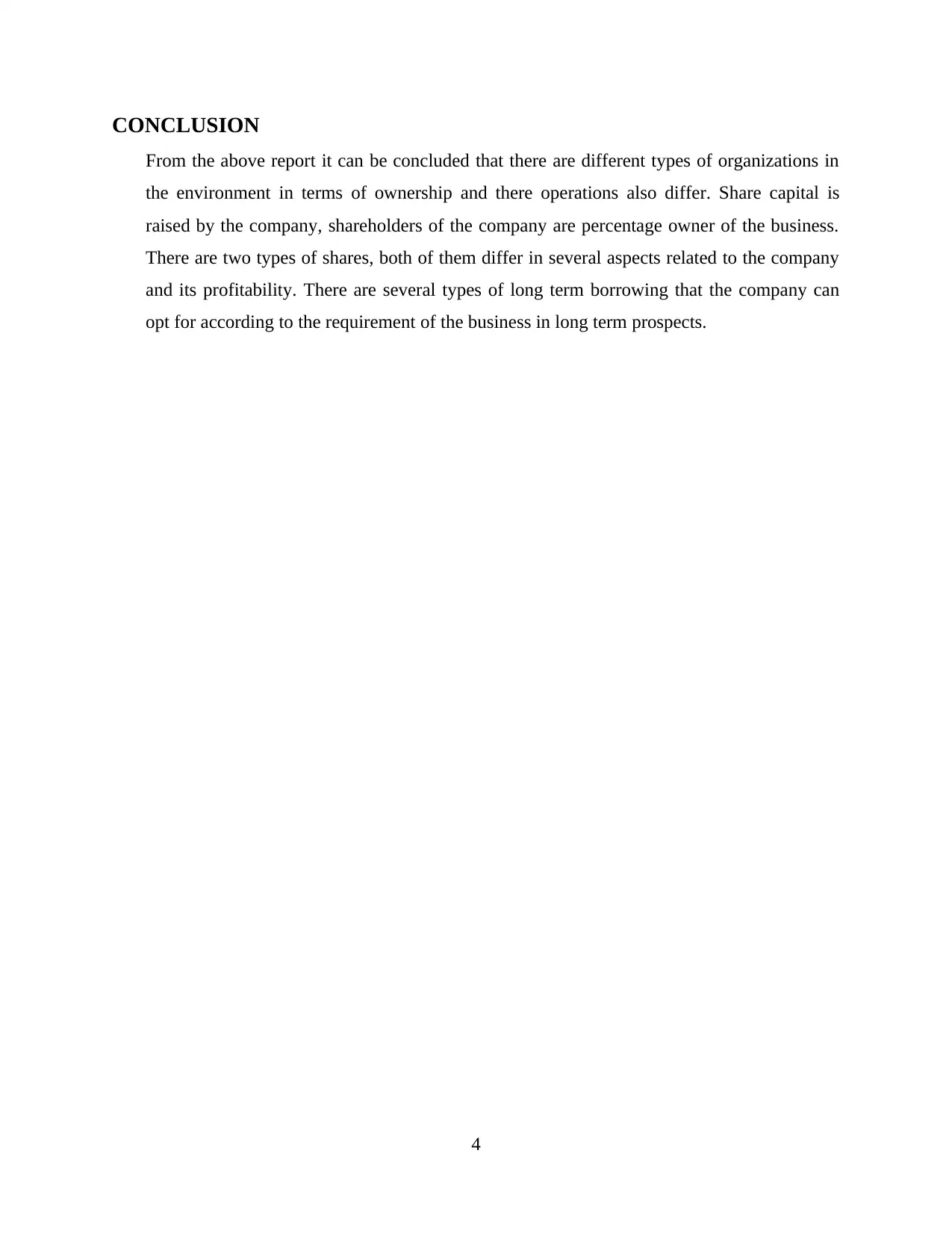
CONCLUSION
From the above report it can be concluded that there are different types of organizations in
the environment in terms of ownership and there operations also differ. Share capital is
raised by the company, shareholders of the company are percentage owner of the business.
There are two types of shares, both of them differ in several aspects related to the company
and its profitability. There are several types of long term borrowing that the company can
opt for according to the requirement of the business in long term prospects.
4
From the above report it can be concluded that there are different types of organizations in
the environment in terms of ownership and there operations also differ. Share capital is
raised by the company, shareholders of the company are percentage owner of the business.
There are two types of shares, both of them differ in several aspects related to the company
and its profitability. There are several types of long term borrowing that the company can
opt for according to the requirement of the business in long term prospects.
4
⊘ This is a preview!⊘
Do you want full access?
Subscribe today to unlock all pages.

Trusted by 1+ million students worldwide

References:
Books and Journals
Imamuddin, A., 2021. An Enterprise Resource Planning System Solution for Small-Mid Size
Enterprises: An Information System Development Case Study. Journal of Computer
Science, Information Technology and Telecommunication Engineering, 2(1), pp.160-168.
LEUCIUC, E.G., 2018. TRANSFER OF SHARES–SIGNIFICANCE, JURIDICAL BASIS,
PRACTICE. Ecoforum Journal, 7(2).
Pinto, J.M. and Santos, M.C., 2020. The choice between corporate and structured financing:
evidence from new corporate borrowings. The European Journal of Finance, 26(13),
pp.1271-1300.
Pradhan, A.K. and Hiremath, G.S., 2020. External commercial borrowings by the corporate
sector in India. Journal of Public Affairs, 20(1), p.e1987.
Vassallo, M., 2017. Preference shares, their canons of construction and their similarities with
debentures: a comparative analysis (Bachelor's thesis, University of Malta).
5
Books and Journals
Imamuddin, A., 2021. An Enterprise Resource Planning System Solution for Small-Mid Size
Enterprises: An Information System Development Case Study. Journal of Computer
Science, Information Technology and Telecommunication Engineering, 2(1), pp.160-168.
LEUCIUC, E.G., 2018. TRANSFER OF SHARES–SIGNIFICANCE, JURIDICAL BASIS,
PRACTICE. Ecoforum Journal, 7(2).
Pinto, J.M. and Santos, M.C., 2020. The choice between corporate and structured financing:
evidence from new corporate borrowings. The European Journal of Finance, 26(13),
pp.1271-1300.
Pradhan, A.K. and Hiremath, G.S., 2020. External commercial borrowings by the corporate
sector in India. Journal of Public Affairs, 20(1), p.e1987.
Vassallo, M., 2017. Preference shares, their canons of construction and their similarities with
debentures: a comparative analysis (Bachelor's thesis, University of Malta).
5
1 out of 7
Related Documents
Your All-in-One AI-Powered Toolkit for Academic Success.
+13062052269
info@desklib.com
Available 24*7 on WhatsApp / Email
![[object Object]](/_next/static/media/star-bottom.7253800d.svg)
Unlock your academic potential
Copyright © 2020–2025 A2Z Services. All Rights Reserved. Developed and managed by ZUCOL.



